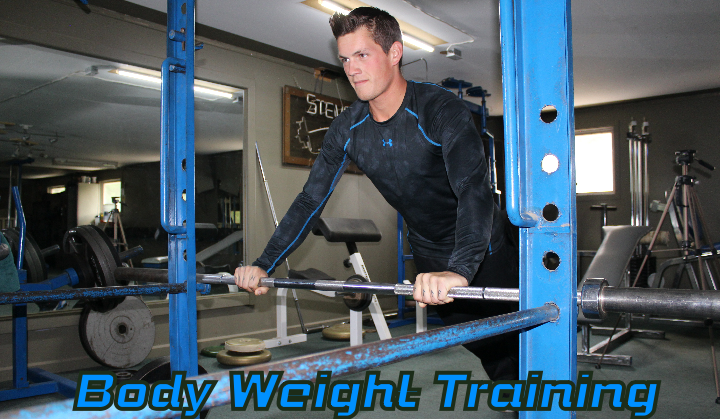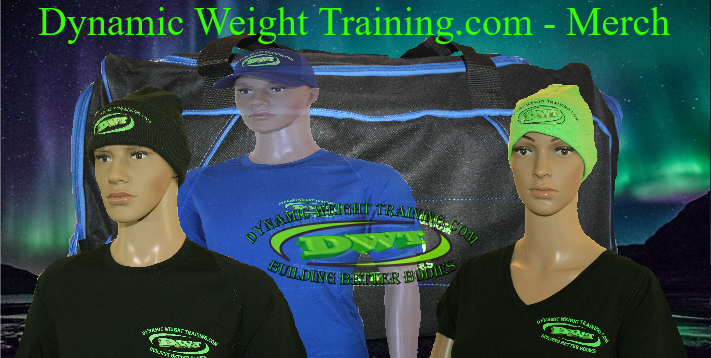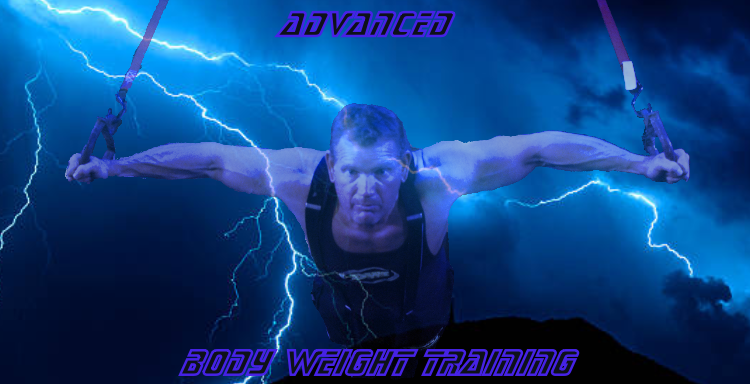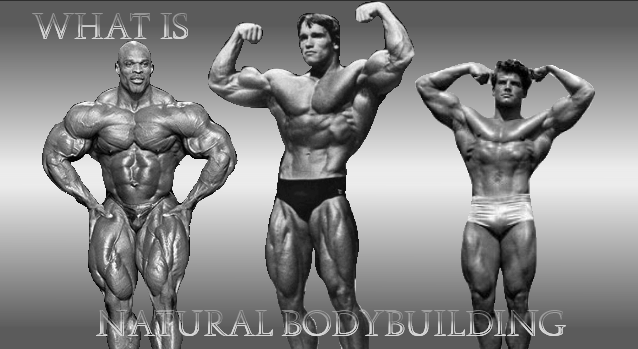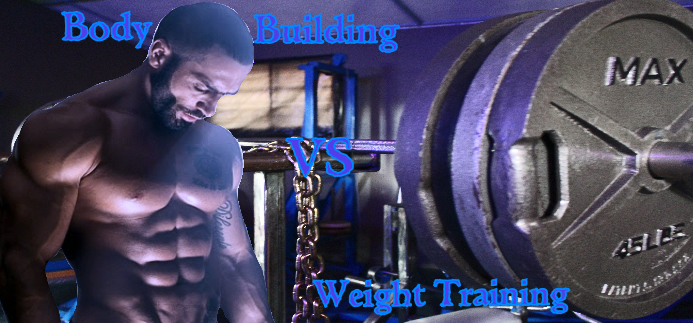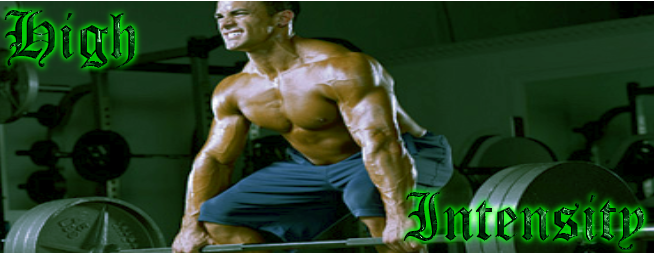Beginner’s Body Weight Training Program
A solid beginner’s body weight training program can change and enhance your strength, muscle structure, it's symmetry, coordination and overall athletic performance. You don’t need expensive gym or rec center memberships, or a host of equipment.
A few simple apparatuses, determination, a positive mental outlook and a willingness to learn body weight training exercises; will put you on your way to building yourself a rock-solid body weight training program.
This
program is aimed at the beginner’s level, without knowing your health or
fitness level, I have provided three different beginner levels; choose one that
suits or describes your condition, age or activity level best. So… keep your
money in your jeans because that’s where your new gym is gonna be.
Advantages of a Beginner’s Body Weight Training Program
What exactly are body weight exercises Anyways?
If you’re not sure, these are exercises you can do on your own almost anywhere in the backyard, garage or a downstairs basement, there simple to perform - at any intensity for any age, gender or athletic level.
(Just don’t mistake simple for easy), the exercises can easily be manipulated in intensity by changing the (angle/elevation, knee and foot or hand position) in most exercises.
The great thing about a decent beginner’s body weight
training program is: if you want to change your athletic or fitness level?
Expensive spacious equipment is not necessary, gravity or resistance provided is where the advantage of using your own body weight comes into play.
Pull-ups can be executed using a solid tree branch or a piece of metal rod or dowelling hung-cross-ways in the rafters of a garage or shop.
Exercise movements such as: pull-ups, push-ups, sit-ups, squats and lunges can be performed anywhere as body weight acts as the primary source of resistance.
Other advantages are: less risk of injury over that of free weights, as your maximum push/pull movements are limited to body weight.
There's also no pressures of gym atmosphere, you go at your own pace, essentially; You Are Your Own Gym. Whether you're a beginner and athletic or maybe conditioning level is on the lower end of the scale, adjusting intensity is easy making the exercises a little more performance friendly. But...
A good beginner’s body weight training program needs one important key element brought to it... (Progression).
Without the proper progression as a beginner, you will more than likely fail to see results in your body weight training program; try to keep this in mind as you go through the article, this is the (key) element to your success
The Importance of Beginners Progression With Body weight Training
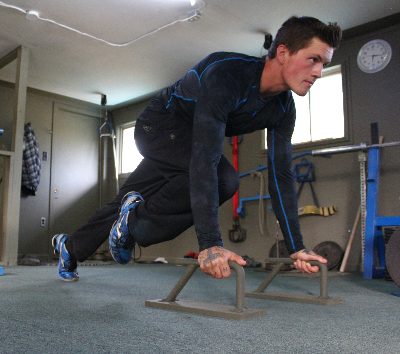
The importance of proper (progression) should never be overlooked at the beginner level, progression, meaning: using or performing exercises that are suited to your athletic level with every effort made at trying to continuously improve your skill, strength and endurance as the weeks and months pass.
The only way results are realized with body weight training is: (get good, really good); by mastering the basics first and using a proper progressive method in your body weight training program.
This is no different than using exercises that suit your lifting level to progress to the next level in weight training.
Often beginners have a habit of moving too quickly to more advanced training methods, too much too fast... yields poor results for an aspiring beginner.
Trying to advance to quickly can show as: sloppy training mechanics, e.g. not following through or executing properly on each exercise, overextending athletic ability often builds overconfidence which can result in an uncomfortable injury.
As a result, muscle growth, definition and strength can suffer as a consequence without proper progression in your body weight training program.
Most body weight exercises incorporate several assisting joints and muscles, a key component to success is to constantly make an effort throughout each exercise to unite the entire body...
e.g., flexing the core, legs and upper body as you move through the repetitions of the body weight movements this isometric action take some practice to master.
Learning to keep your movements strict smooth and controlled like a gymnast; learning proper balance, how to plank and isometrically flex at the termination point of each repetition is all part of the natural progression of learning and building these exercises into a solid body weight training program.
Beginners Body Weight Training Exercises
Just before we dive into the body weight training program, there is no one-size-fits-all routine/program that is going to satisfy or fit everyone perfectly.
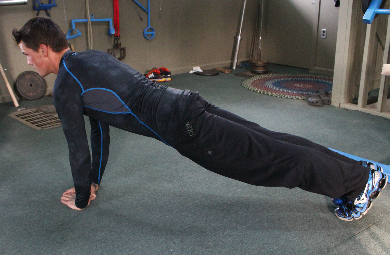
As beginners or intermediates for that matter it’s difficult
to say with any certainty what each person’s goals, natural strength curve, athletic
ability, age or gender is: as everyone is different with their wants and needs.
Keep your athletic level in mind; try not to overextend your ability in these exercises when you’re first getting started. Choose a level you can handle confidently until your natural strength increases to match a competent and confident level.
Chose A Level That Shadows Your Current Fitness Level
Beginner Level I
For the absolute beginner; if you have been out of school/college or working for more than four or five years but have been relatively inactive.
Choose 3 or 4 of the exercises from the menu when first
starting that you know, or think you can handle, such as push-ups, sit-ups,
etc. e.g., pushing off of the hands and knees instead of the toes and hands.
If you're only getting four or five reps on most exercises, change the exercise angle to lessen resistance for the exercises, if you're getting 7 or 8 reps, continue to work at being progressive...
Using the exercises twice a week is an experimental stage in your body weight training program, to see how your body copes with exercise stress and DOMS e.g., (delayed onset of muscle soreness) over the next few days and weeks.
Beginner level II.
The Novice beginner; You’ve been out of college or post-secondary education for 5 to 10 years or more, regularly play sports, jog, etc., 1 -2 times per week. You have some confidence in your athletic ability, but want to improve on your strength.
Perform 4 to 6 exercises with 1 – 2 sets of each exercise, (depending on exercise difficulty, look to try and perform 8 to 10 repetitions in each exercise). with the exception of sit-ups or push-ups, etc.
Don’t push too hard in the beginning, there’s a big difference from strength and endurance inherited from recreational sports; as compared to unifying and building upper and lower body strength using specific body weight strength training methods.
These exercises can be challenging and taxing to say the least.
Beginner level III
Active Sports minded beginner; you’re naturally strong, reasonably conditioned/athletic, between the years of 16 and 35, confident, looking to increase strength without the hassle or heavy cost of gym fees.
Again: because body weight exercises are challenging, I would suggest giving yourself a 2 - 3 week experimental break-in period, simply because the exercises are likely knew to your fitness program.
Once your break-in period is over, you can increase intensity by
adjusting angle, foot and hand position, e.g., push-ups: raise your feet up onto a chair,
bench, couch or bed.
This puts more stress on the shoulders, triceps and chest. (early on the use of a mirror also helps with training form).
Level III suggestion: perform 5 to 7 different exercises in your body weight training program 2 – 3 times per week; rep range for most exercises should be between 10 and 15.
This rep range will border on increasing strength and endurance. If you’re only interested in strength, decrease each set-range by a few reps.
As you continue in your body weight training, always monitor strength and fitness progress, as strength and confidence continues to grow, adjust training and exercise intensity to suit your goal or fitness needs.
Note: No matter what level you’re capable of training at; always take the time to warm up the entire body, whether it’s with some:
- Light cardio
- Calisthenics
- Shoulder, waist and hip rotations
The choice is yours, just be sure to warm-up always!
Keep in mind: body weight exercises differ from that of weight training. You’re not trying to do a one rep max, forced reps or take each exercise to the point of complete physical exhaustion or failure.
Key points to performing these types of exercises:
- Keep the exercise movements as smooth and controlled as you possibly can, these exercises are about building control into the movements, learning to plank properly as you’re pushing and pulling; it's about trying to unify upper and lower body strength by building a powerful core, meaning: the abdominal's, serratus, obliques and lower back muscles.
- The lowering or eccentric motion of each movement should be done, slightly slower with lots of control
- The pushing or pulling or concentric part of each movement should be performed slightly faster, even explosive if you’re conditioning will allow it on most exercises. Take the time to learn each movement and follow through on every rep with a full range of motion (FRM).
- Here’s where a lot of beginners and intermediates don’t understand the importance of the termination point of each exercise. This is where you have an (isometric contraction) e.g., if you’re performing push-ups; each time you come to the top, squeeze the chest muscles at the termination point on every rep, even at a beginner level, learn to perform them properly.
- As mentioned don’t train until failure, as you feel your strength begin to decrease or wane in each movement, it’s probably time to bring the exercise to a close.
- For the first several months as a beginner the learning curve might be somewhat erratic, adding in extra exercises for weaker areas and decreasing some movements for stronger ones. As you become stronger, you will have to regulate the exercises and intensity, including your rep and set range to suit your athletic goal.
If Your a Complete Beginner, Lets Start With
Level 1: Monday
Using Monday’s strength reserves for upper and lower body:
Lets start with 2 exercises with a 25 sec. rest between each exercise: preforming these in back-to-back fashion. At the end of the 2nd exercise take a 30-40 second break before starting the next exercise sequence.
Monitor rest times closely if you need more in the beginning, take more; as strength and recovery times improve shorten up the rest times.
Note: Keep in mind this is only where your starting; strength is built through progression.
Incline bar push-ups VS Chair or box Squats
Incline bar push-ups, Reps 10 - 12: Choose a shoulder width grip push-up plank position, lower chest to touch bar, return to starting position.
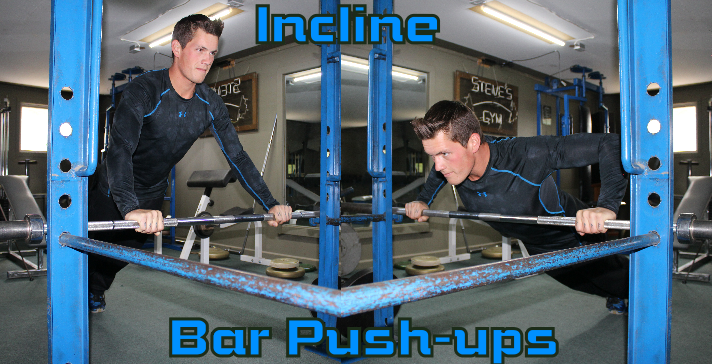
Areas worked... Shoulders, Triceps, Trapezius and Pectorals.
Note: as your starting, especially at the Beginners' level I, be mindful of the angle your body is at, maintain a straight plank as shown this will help increase core strength and exercise form.
Chair or box Squats, reps 12 - 15: keeping hands crossed in front, with chair located to the rear from a standing position, lower until the top of the your rear lightly touches the chair and repeat. Move at a smooth steady pace; don't allow any rest until exercise completion.
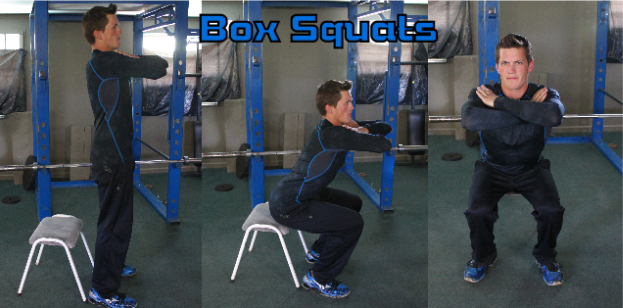
Areas worked... Hips, Quads, Glutes and Hamstrings.
Incline Biceps Pulls VS Stationary Alternate Leg Lunge
Incline Biceps Pulls. Reps 8 -10 preform these on a steeper incline in the beginning. With hands facing inwards, inside shoulder width grip start; with arms fully extended, pull-upwards until hands are close to the chest then release under control to starting position.
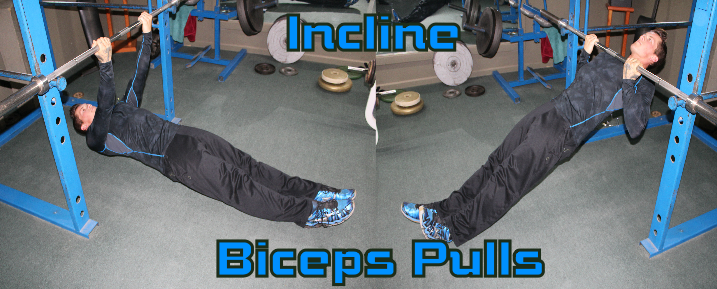
Areas worked... Biceps, Shoulders, Trapezius, Forearm flexors and Abs.
Stationary Alternate Leg Lunge, Reps 8 - 10 each leg: step out with the first leg in a deep lunge, keeping the toe in front of the knee for a nice stretch return to the start and repeat for the rep range shown. For the first 2 - 3 weeks you may want to try 6 - 8 reps, if done properly these really stretch and can be felt the next day.
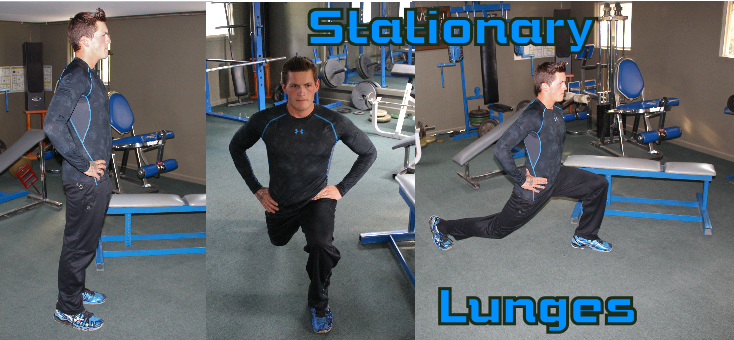
Areas worked... Quadriceps, Hamstrings and Glutes.
Chair Dips VS Wide Stance Alternate Leg Lift Side Crunch
Chair Dips, Reps 6 - 10: chair or box dips should be performed with feet out far-enough for the lower back to barely clear the chair, lower into the exercise as deeply as you can, push back out, squeeze the triceps and shoulders at the top in this exercise.
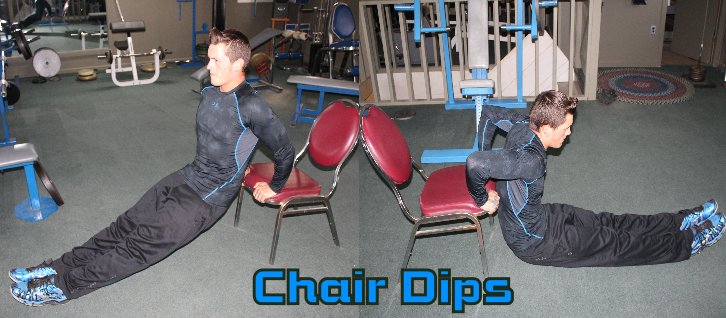
Areas worked... Pectorals, Triceps and Shoulders
Wide Stance Alternate Leg Lift Side Crunch, Reps 10 -12 ea. side: Starting in a wide stance crouching position, with hands behind the head; alternately lift one leg at a time pulling the knees as close to each side as possible while leaning sideways with the same side elbow; try for a nice squeeze on the hips and sides at the top of each movement.
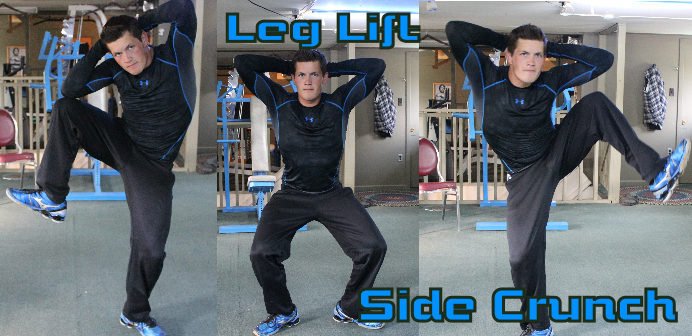
Areas worked... Obliques, Quads and Glutes
I’ve included both upper and lower body exercises, in the beginners level I, pick 2 or 3 different exercise combinations out of the 4, try to perform them as shown.
Level 1: Thursday
Focusing mid-week on core strengthening exercises for level 1.
Lying leg raises VS long arm crunches
Lying Leg Raises, Reps 10 - 15: preform these with toes together, pointed forward, knees only slightly bent. Bring the legs up together, but stay back from vertical, to keep tension on the mid section, lower feet to floor, while trying not to allow them to touch, repeat until desired reps are achieved.
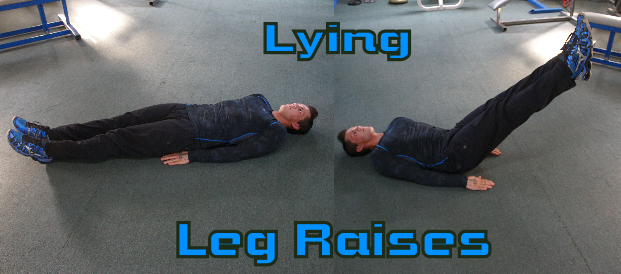
Areas worked... Internal obliques, Lower abdominal's and Hip Flexors
Long Arm Crunches, Reps 10 -15: Lying flat on your back arms out stretched behind the head, Knees bent, pull yourself forward uniformly using the ABS as much as possible, this is a crunch exercise, so really contract once you've come up as far as you can, then return to the starting point.
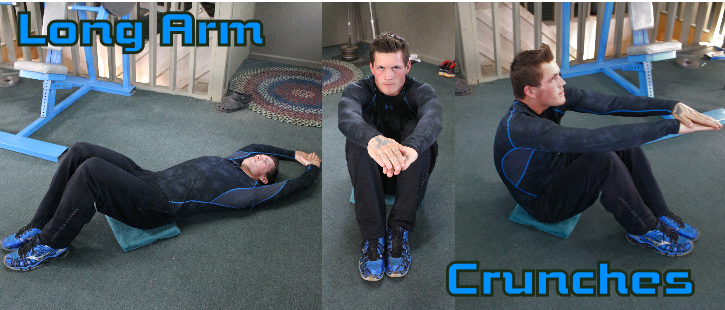
Areas worked... Upper and Mid Abdominal's, Shoulders and Hips.
Seated Twists VS Stiff Legged Dead lifts
Seated Twists, Reps 18 - 20, while in a seated position, raise feet off the floor a few inches, with knees bent holding arms together, begin twisting from side-to-side while maintaining a slight backwards angle with your upper body, this keeps tension on the ABS and helps with balance.
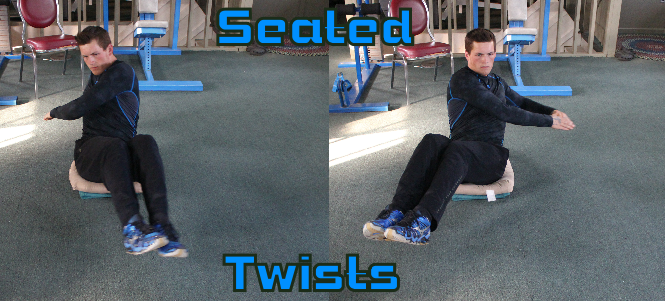
Areas worked... Serratus, Internal and External Obliques, Hips and Abs
Stiff Legged Dead lifts, Reps 12 - 15 standing on a block of wood or floor keeping feet 6-8 in. apart, lower down until hands are close to your feet palms facing in, pull back to start with the lower back and shoulders. You can preform these with resistance or not. All lower back, leg biceps exercises do tend to stretch more than other muscle groups, so you may feel mild fatigue the next day.
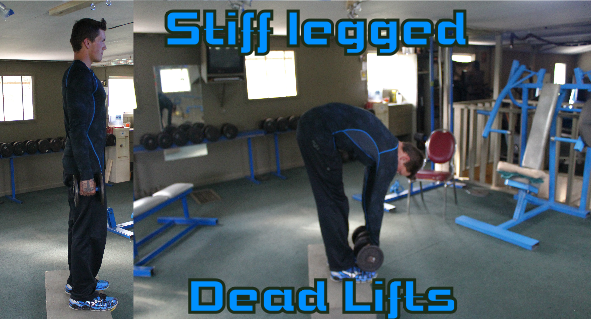
Areas worked... Shoulders, Lower back, Hamstrings and Glutes
Air Biking VS Good mornings
Air Biking, Reps 10 -12 ea. side: sitting on the floor in reclined fashion, hands and legs extended forwards out in front, alternately begin pulling the knees toward yourself, just as you would riding a bike.
Note: practice with the angle and movement until you find the right position that gives the best balance.
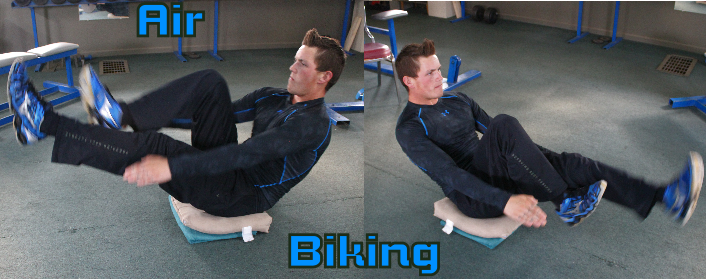
Areas worked... Obliques, Abs, Shoulders, legs and Hip flexors
Good Mornings, Reps 12 - 15, standing straight with hands resting on the hips, lower down to a 90 degree position while keeping the legs stiff, then return. It's a simple exercise but it really works lower back.
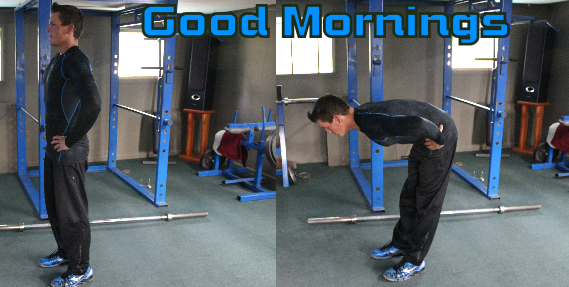
Areas worked... Lower back, Leg biceps and Glutes
Beginners Level 2: Monday
Again; take time to warm-up before moving into the exercises:
Preforming the exercises in (Super set fashion), resting 15 - 20 sec. between exercise sets and 25 - 30 after the second super-set before moving on to the next super set in the exercise menu.
Sideways Lunges VS Reclining elbow Knee lifts
Sideways Lunges, Rep 10 - 12 standing with feet 8 - 10 in. apart, hands on the hips, step sideways with a leading foot approx. 24", in deep stretch sideways lunge. You should really feel this in your legs. You can preform these with hands at your sides or on the hips.
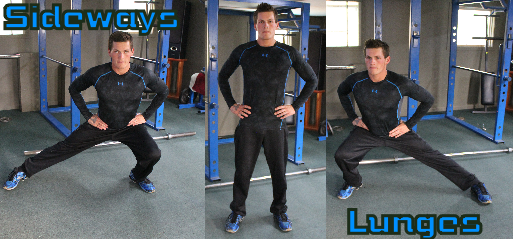
Areas worked... Lower back, Fronts and Backs of upper Legs and Glutes
Reclining Elbow Knee lifts, Reps 10 - 15: angled back on the floor resting on elbows, have feet out in front, 12" off floor, pointed straight ahead, pull feet inward until knees come as close to the chest as they can, give an abdominal squeeze and return to start.
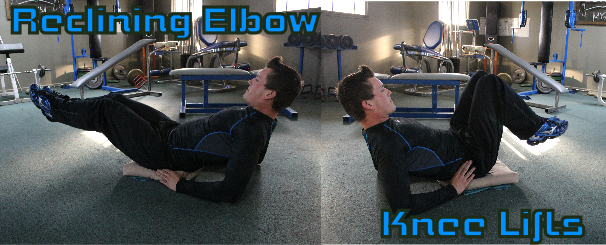
Areas worked... Legs, ABS and lower back
Diamond push-ups VS Forward Lunges
Diamond push-ups, Reps 15 - 18: assume a push-up position only this time, take the time to make a diamond shape with your thumbs and fingers on the floor. maintaining a strong plank, lower yourself under control so chest is close to floor, push back up quick but smooth.
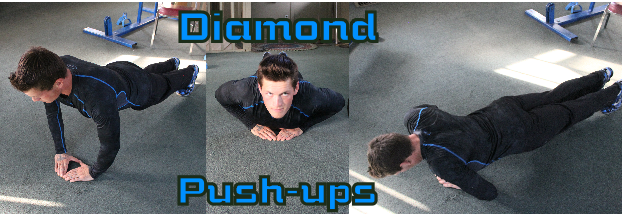
Areas worked... Chest, Triceps, Trapezius and Front Delts.
Walking Lunges, Reps 10 -12 each leg: from a standing position, hands on the hips, step forward with your right leg into a deep stretch lunge-keeping the toes extended past the knee. At this point drive back up with the powerful quad muscles, preforming these alternately as you walk in a single direction.
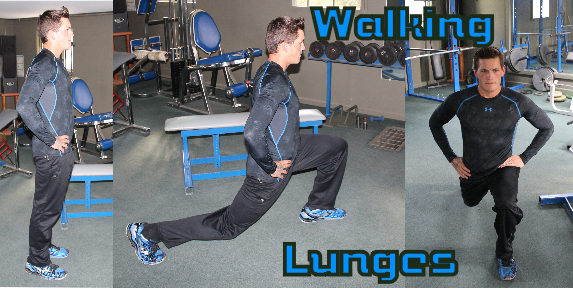
Areas worked... Quadriceps, Hamstrings and Glutes
Mountain Climbers VS Good Mornings
Mountain Climbers, Reps 10 -12 each leg: assume a push-up plank position; while maintaining this position pull one leg up at a time towards the chest while maintaining balance.
Note: you can preform these with floor handles as shown or hands flat on the floor.
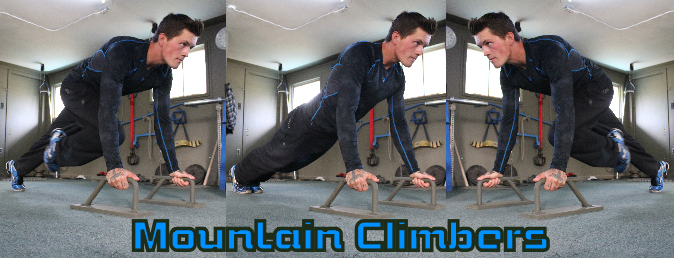
Areas worked... Abs, Chest, shoulders, Triceps, Hamstrings and Glutes
Good Mornings, Reps 20 - 25: standing straight with hands behind the head, lower down to a 90 degree position while keeping the legs stiff, then return. It's a simple exercise but with the hands located behind the head this adds more body weight resistance to the lower back.
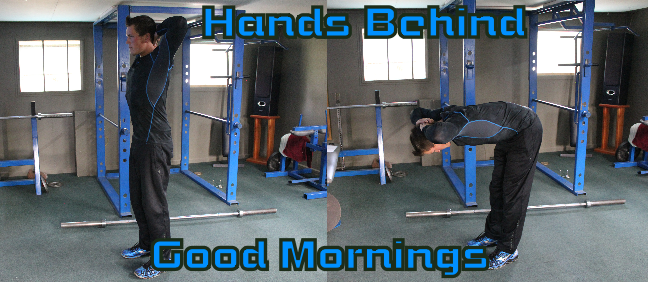
Areas worked... Abs, Hamstrings, Lower back and Glutes
Crouching Shoulder Press VS Crouching Rope Pulls
Crouching Shoulder Press, Reps 8 - 10: starting in an arched position, hands extended past the shoulder as shown, lower to the floor slowly allowing the knees to bend slightly as you lower, stopping just before your head touches floor: use the shoulders to receive the resistance, push back-up to the start and repeat.
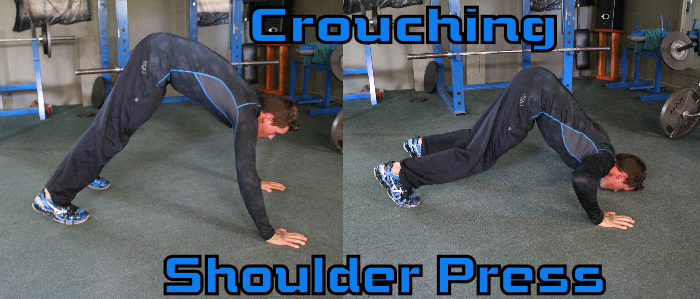
Areas worked... Lower back, Shoulders, Triceps and Trapizus
Crouching rope pulls, Reps 8 -10: Keeping a bent knee or squatting position, while maintaining a shoulder width grip, pull your body forward using the arms and back muscles. Hands should be close to your sides at this point; then release back to the start.
Note: a towel, belt or rope apparatus will work for this exercise.
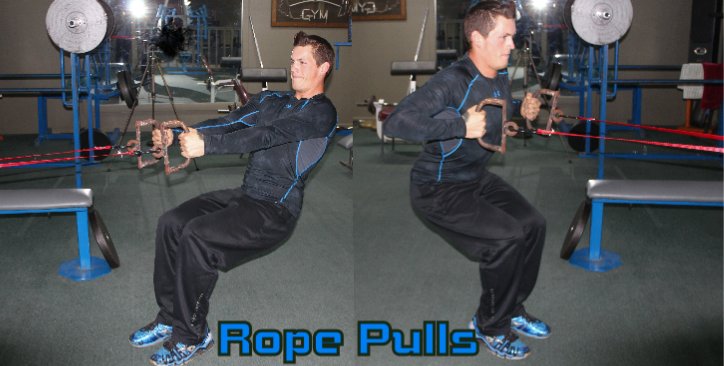
Areas worked... Upper-back, Biceps, Forearms and Trapezius
Level 2: Thursday
Mid-week lets focus a little more on abdominal, lower back (core) work, to strengthen these areas.
Cross Chops VS Knee to Elbow Crunches
Cross Chops, Reps 10 - 12 ea. side: assume a wide stance with hands-together over the shoulders as illustrated, begin: to lower down and twist in the opposite, direction to the left, until your in a twisted crouch position, allowing the your body weight to rest on this leg momentarily. Complete our reps then move to the opposite site.
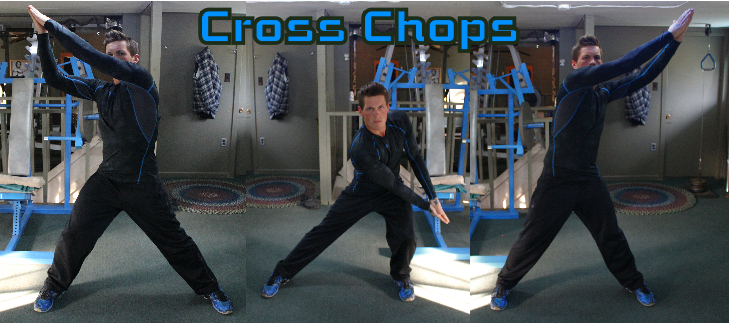
Areas worked... Shoulders, Quads, Abs, Obliques and Serratus
Knee to Elbow Crunches, Reps 10 ea. side: lying flat on the floor, with hands behind the head, lift-up and pull the right elbow cross-ways toward the left knee as your raising it simultaneously towards the right side of the chest.
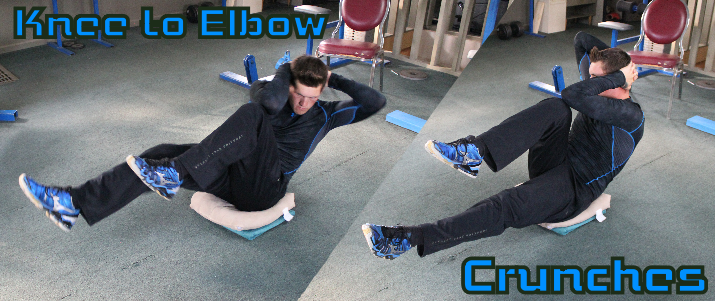
Areas worked... Upper-Abs, Glutes, Obliques and Hips
Good-Mornings VS knee-up-crunches
Good-Mornings, Reps 15 -20: in a standing position; start with hands together in front, lower into a prone position while keeping your hand out-in front. Return to the start and repeat, having the hands supported out in front by the lower back you may notice, does add more stress to the the lower back.
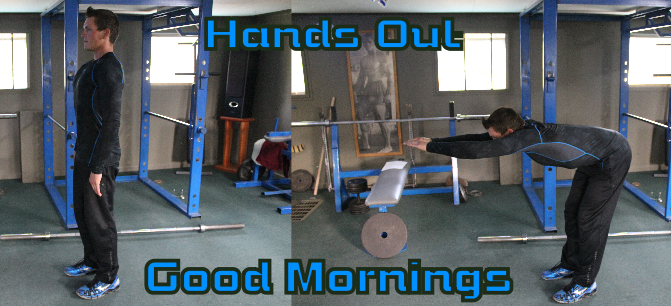
Areas worked... Lower back, Shoulders, Glutes and Rear Leg Biceps
Knee-Up-Crunches, Reps 10 - 15: While using a semi-prone position on a chair, bench or the floor, lean back slightly to counter balance the weight of the legs, keeping the toes together, pull the legs forward toward the chest, hold momentarily while supporting and balancing with the hands and elbows, return to start.
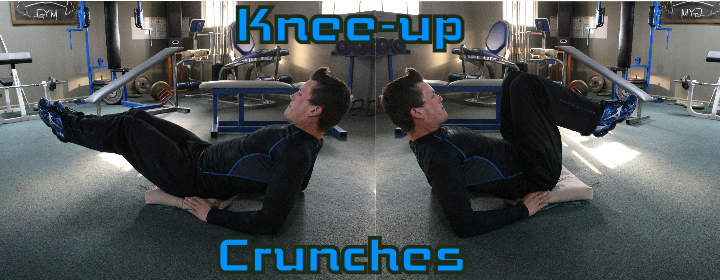
Areas worked... Hips, Abs and Lower back
Alternating Elbow-Side Plank Rotations VS Seated Punches
Elbow-Side Plank Rotations, 8 -10 ea. side: while maintaining a push-up plank position, allowing the body to rest on the forearms, shifting your weight to the left side, with the right-swing the limb up over your head inline with the shoulder - while maintaining your balance with your plank. Return and repeat the same on the opposite side.
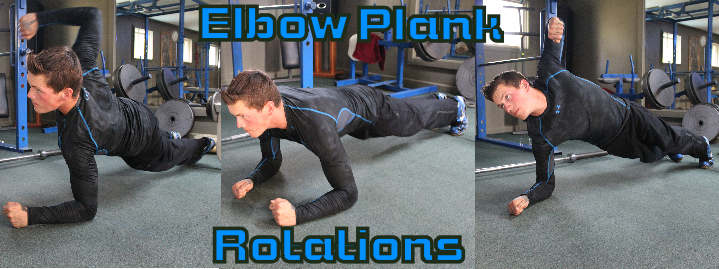
Areas worked... Lower back, Shoulders, Serratus, Triceps Abs and Chest
Seated Punches, Reps 12 - 15 ea. side: seated semi-prone position starting with the right hand, make a fist and cock to your shoulder; punch forward in a smooth explosive motion across the trunk at shoulder level, then alternate as shown for desired reps.
Note: to add resistance you can hold small dumbbells or soup cans etc.
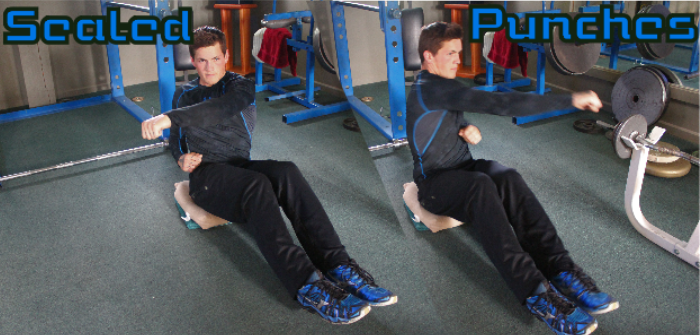
Areas worked... Shoulders, Arms, Abs, Obliques, Hips and Serratus
Beginner Level 3: Monday
For the beginner level III athlete we've added a few more challenging exercises to keep a natural progression moving forward for you. Remember: change angles or resistance where needed to encourage progress.
Preform the exercise groups in (Super set fashion), minimize rest between the super set 10 - 15 sec. with a 20 - 30 sec. break after the super set, narrow up rest times where ever you can as athletic strength and endurance increases.
Narrow Grip Triceps Push-ups VS Hanging biceps bar pull-ups
Narrow Triceps Push-ups, Reps 10 - 15: you can preform these with hands on the floor or with portable push-up handles. keep your thumbs towards you, hands inside shoulder width, lower deep into the exercise then push back to the start with some speed, contract the triceps at the top momentarily, then continue the exercise.
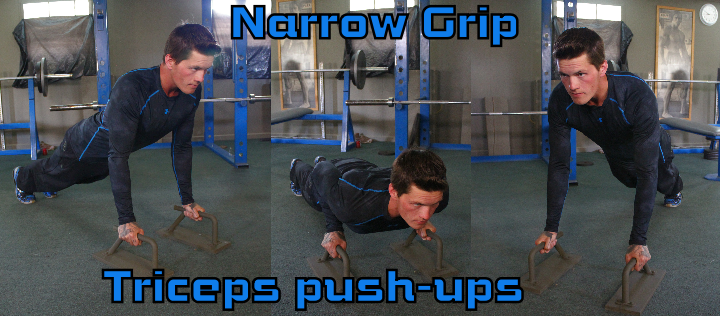
Areas worked... Chest, Core, Shoulders and Triceps
Hanging biceps bar pull-ups, Reps 10 -15: assume a fully extended hanging position, while having an underhand curl grip 6 - 8 in. apart; curl yourself upward until your chest comes close to the bar. Try to move upwards quickly and lower slower under control, using only the arms.
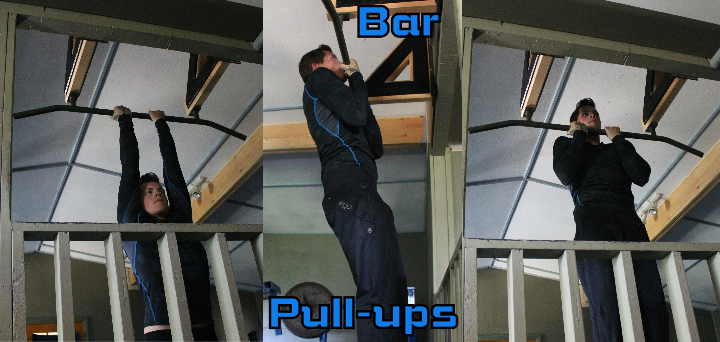
Areas worked... Traps, Forearms, Upper back and Biceps
Planking Alternating Toe Taps VS Leg Raises
Planking Toe Taps, Reps 8 - 10 ea. side: assume a push-up plank, shifting your weight slightly to the left, use the right arm to tap the left toe as you raise it simultaneously, repeat for opposite side.
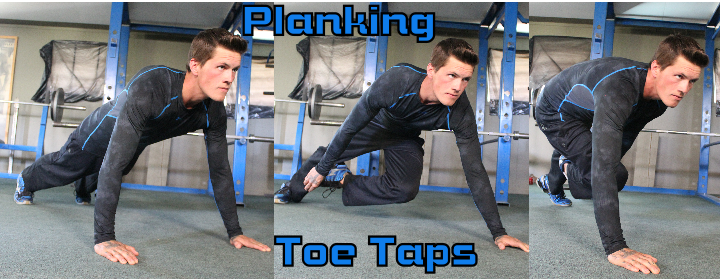
Areas worked... this exercise is great for working the core and extreme upper body.
Leg Raises, Reps 10 - 15: Reclined back resting on elbows, toes pointed forward, lift the legs off the floor a few inches, pull the knees towards you as far as you can; return to starting point. Note try to use some form of resistance here as shown if you can, this can be a book can of soup or anything.
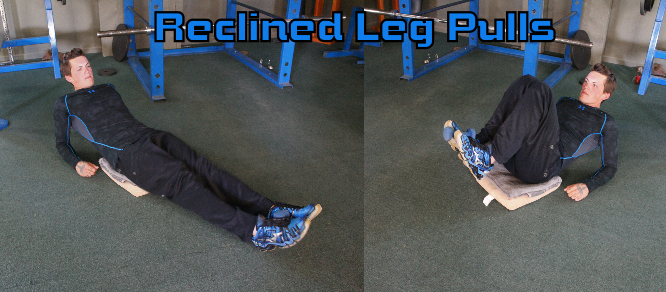
Areas worked... Hips, Legs, Internal obliques, and Lower abs
Triceps Bar Dips VS Split Squats
Triceps Bar Dips, Reps 10 -12: Grip the bar firmly, hands shoulder width apart, begin by lowering under control until you feel a nice deep stretch in the chest and shoulders, push back-up to start position and repeat.
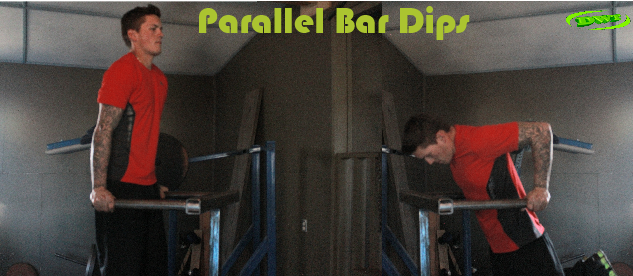
Areas worked... Shoulders, Chest and Triceps
Split Squats, Reps 8 - 10 ea. leg: these can be preformed on a bench or a chair, with your left leg resting firmly, leading with the right leg, maintain a 90 degree angle with your upper body to your pushing leg. Once your fully extended, lower under control until you've attained a deep stretch, push back to start and repeat, finish with one leg before moving to the other.
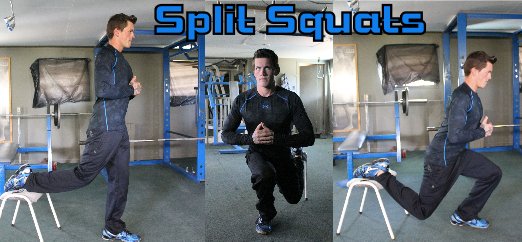
Areas worked... Quads, Rear and Sides of legs, Glutes and Calves
Paint pail squats VS Elevated Bar Push-ups
Paint pail squats, Reps 10 - 12: assuming a standing upright position with a full paint pail in each hand, feet 10 - 12 inches apart, start: lowering yourself into a 90 degree position (quads parallel to the floor), once this position is achieved and a good stretch is felt in the legs - push back out to starting position.
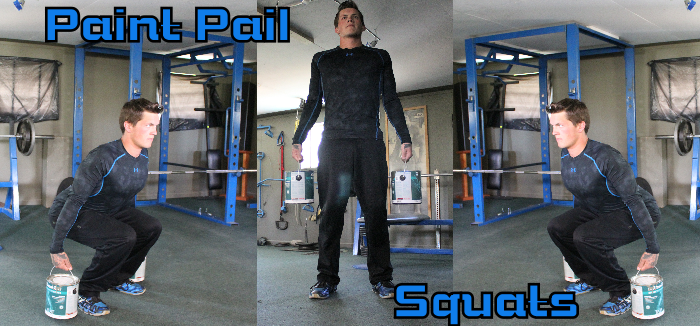
Areas worked... Fronts and backs of legs, lower Back, Arms and Glutes
Elevated Bar Push-ups, Reps 10 - 12 ea. this exercise is similar to the one in beginner level I, the difference is: a 10" stool has been added to raise the feet and the push-bar is lowered by 6", this might not sound like much: but, it really increases resistance in the body weight training program.
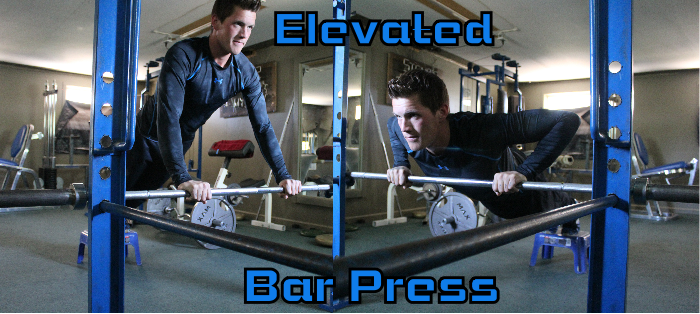
Areas worked...Chest, Triceps, Shoulders and Trapezius
Level 3: Thursday
Its Thursday for the level 3 athlete; lets begin by taking core training seriously and take your ab strength and development to the next level.
Sideways Crunches VS Elevated Leg Crunches
Sideways Crunches, Reps 8 -10 ea. side: lying straight on your left side with right hand behind the head, begin by: lifting yourself up-sideways with feet together and upper body moving towards the hips simultaneously, Keep left hand flat on the floor, out from your side, to help stabilize and maintain balance.
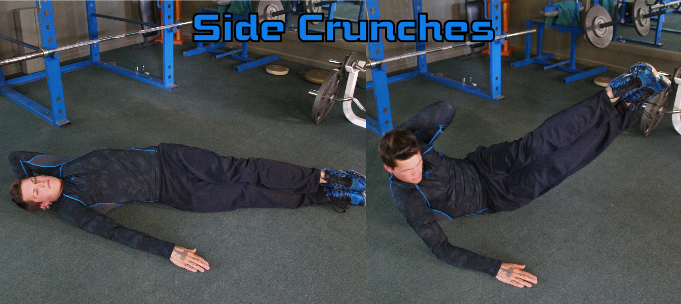
Areas worked... Abs, External obliques, Serratus and Hips
Elevated Leg Crunches, Reps 12 - 15 or more: lying flat with feet elevated on a bench or chair, arms folded across the chest, pull yourself upward rolling inward to form a crunching motion as you come to the top of the movement - return to start and repeat.
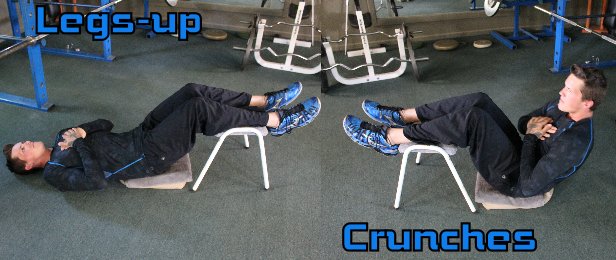
Areas worked... Upper Abs, Hip and Leg flexors
Planking (cross climber toe taps) VS Skydive-pike rolls (Legs straight toes forward)
Planking (cross climber toe taps), Reps 10 - 12 ea. side: starting in a plank position, shift your weight slightly to the left, use the right arm to tap the left toe as you raise it simultaneously, repeat for opposite side, preform these alternately.
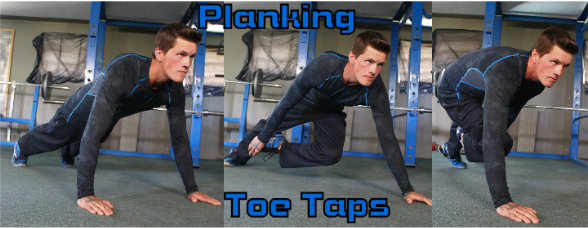
Areas worked... Shoulders, Chest, Lower back, Abs, Hips, Serratus and Glutes
Skydive-Pike Rolls, Reps 10 -15: lying flat, arms with hands together out stretched behind your head, begin by pulling your self upwards, (Legs straight toes forward), as hands and toes begin to meet you should now be forming a pike position, complete as many as you can.
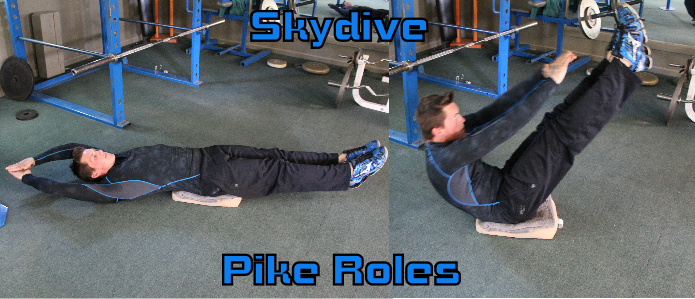
Areas worked... Upper/lower Abs, Obliques, Hips and Shoulders
Good Mornings VS Side-Bends
Good Mornings, Reps 20- 30 starting in a standing position with hands behind the head, keeping the legs straight lower your trunk until parallel to the floor and return. this is an easy exercise but can leave the lower back feeling fatigued if your not conditioned at the start.

Areas worked... Leg, biceps, Hips, Glutes, Lower back and Shoulders
Side-Bends, Reps 25 - 30 ea. side: standing with feet 8 - 10 in. apart, hands on hips, lower the upper body angling in the direction of the left leg as deep as you can without bending your legs, return to start, repeat opposite site for desired reps. Maintain a good pace, keeping the movements smooth.
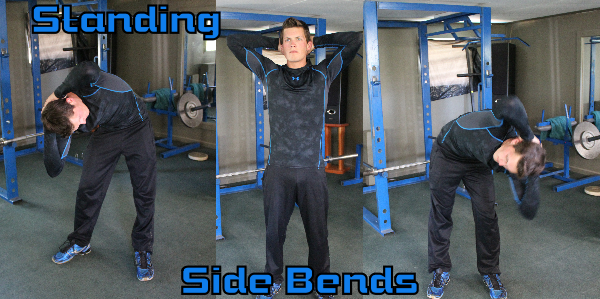
Areas worked... Hips Glutes Lower back and Serattus
Seated Twists VS Rotation Planks
Seated Twists, Reps 8 -12 ea. side: lets move the resistance level up some... seated on the floor holding a rock eg., 10 -12 pounds. Start with: upper body leaning back slightly, with hands in front, feet out stretched off the floor enough to counter-balance with the rock. Move the legs left with knees slightly bent and the arms to the right alternating, keeping the movements as smooth as possible.
Note: anything can be used as resistance such as: a text book, brick, cans of soup, etc.
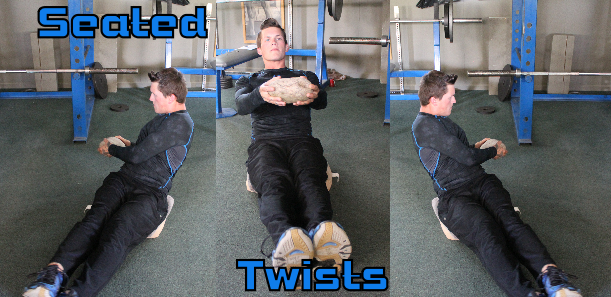
Areas worked... Shoulders, Abs, Hips, Serratus and Upper Leg Flexors
Plank Rotations, Reps 8 - 10 ea. side: assume a plank position, hands slightly wider than shoulder width. Shift your weight to the left shoulder, lifting the right hand raise the arm until pointing Skyward, while keeping the hands in line with the shoulders, alternately repeat with each limb until desired rep range is achieved.
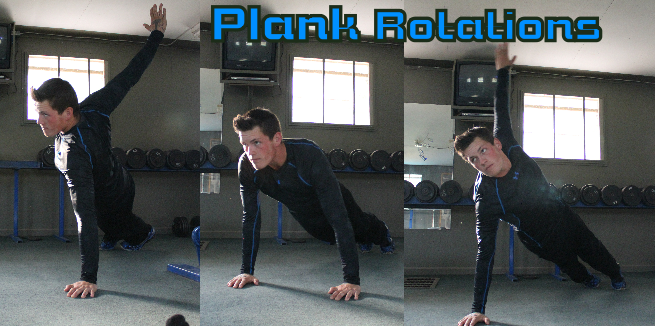
Areas worked... Shoulders, Triceps, Chest, Lower back and Abs
How to progress in the beginners Body weight training program
Body weight Rules?
I have covered some of the rules for beginners in your body weight training program. As a recap - be progressive as you become stronger; but, keep it at a pace you can handle.
If the main focus or goal is to increase strength: then the lower end of the repetition spectrum would be more beneficial in the 6 - 8 rep range. If you want the best of both worlds, increasing strength and endurance 10 - 15 would build a positive balance in this area.
Note: ultimately, strength is built by adding resistance, taking short breaks to let muscle and oxygen reserves recover between exercise sets.
To increase endurance: exercises should be performed with little or no rest in between sets with higher rep values as mentioned (keep reps under 25 unless specified).
Training frequency: for the absolute beginner 1 - 2 times a week should be plenty, this is the adjustment time needed to get used to the rigors of these exercises. Once your conditioning level increases, 2 – 3 times per week should show great results as the weeks and months pass.
Increasing Strength Through Change
To increase overall body strength-change exercises and there order, add variations of angles, foot and hand position ultimately changes muscle, joint and neurological stress.
As stress levels change so will your strength curve, your body is an engineering, evolutionary marvel, it does one thing and does it well, it adapts!
Once you can easily perform 15 repetitions of all the exercises in the body weight training program, then it’s time to start elevating foot or hand position increasing the intensity and lowering the repetitions is what will increase overall body strength and control.
The Unique Look: advanced body weight athletes look very different than weight trained athletes; although heavy training weight lifters do have an edge of overall body mass and muscularity, body weight athletes look defined, sinewy and highly athletic.
Progressing as Strength Increases
Inevitably, if you use a solid body weight training program, as time passes you will begin to move well beyond the beginner level.
See Advanced body weight training with full video instruction on technique of advanced exercises.
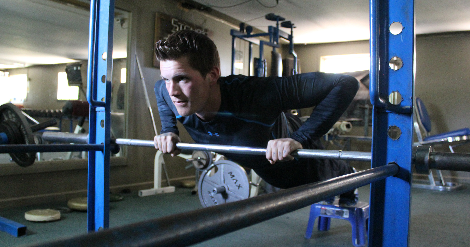
If the advanced routine is to - advanced for your current
fitness level, change the resistance and angle from a few tougher beginner
exercises and choose a few of the advanced exercises that you can execute. This
will help make a natural intermediate progression.
Make every effort as an intermediate to get stronger and ultimately make it to the advanced body weight training stage.
Concluding:
Body weight training is not bodybuilding, this is not about how big or massive you can make yourself, in fact, it’s just the opposite. It’s about unifying upper and lower body strength, building strong, sleek muscle, that’s used in real-world applications such as: daily activities, sports, work, etc.
This type of look has a very strong social appeal; men and women of all ages are attracted and even admire this look. Body weight training is about building a better stronger body that fits and suits You; take the time to make a clear mental picture of a realistic goal you’re going to achieve!
Learn the exercises and the skill to achieve them... in turn your body will reward you by becoming stronger, leaner, sexier and who couldn’t use a little of that. The more you love what you do, the better you'll look and feel.
Make your training and goal real; these exercises work and work well, with some hard work and time-you will see results! Take the time to take good care of your body and it will return the favour.
DWT
